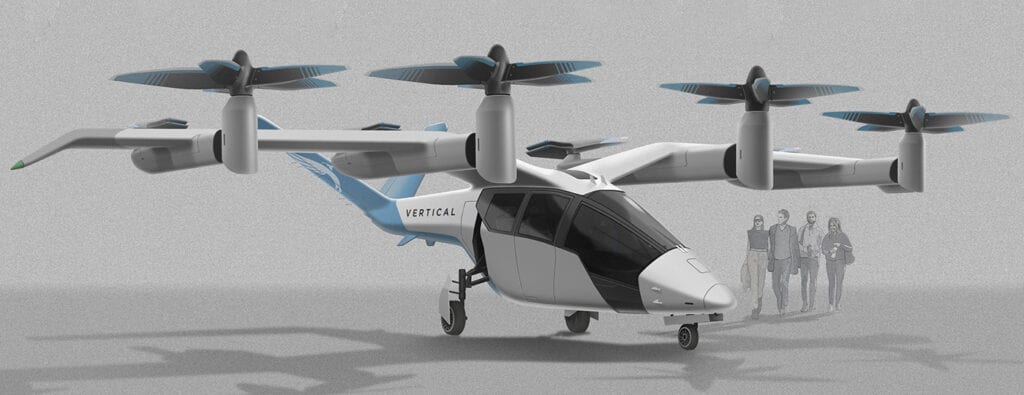
With its new VA-1X air taxi design, a significant departure from its previous ‘Seraph’ multicopter, Vertical Aerospace targets 2024 for commercial operations. (Vertical Aerospace)
Vertical Aerospace, Britain’s leading entrant in the race to commercialize electric vertical flight, unveiled the VA-1X, a vectored-thrust air taxi that represents a significant departure from the company’s previous multicopter design.
Specs of the VA-1X, according to Vertical:
- Range: 100 miles
- Cruise speed: 150 mph
- Noise: 30x quieter than a helicopter
- Capacity: 992 lbs payload, or four passengers plus luggage (and a pilot)
Images of the VA-1X released by Vertical Aerospace indicate a design highly efficient in cruise flight, with a 49-foot wingspan and V-shaped tail. The aircraft is powered by eight propulsors, four on each wing. Video footage released by Vertical show the rear four propellers as fixed, assisting with takeoff and landing, while the front four tilt forward to transition the aircraft into cruise flight.

Artist rendering of Vertical’s VA-1X in the skies above London. “You could travel from London to Brighton in approximately half an hour, compared to two hours driving, or an hour by train,” Vertical’s website states.
Vertical’s previous design, the Seraph, employed twelve overhead propellers in a multi-rotor fashion to lift a maximum of 550 lbs at speeds up to 50 mph. Shifting toward a far more efficient design with vectored thrust and numerous control surfaces, Vertical has chosen to undertake a more complicated project that will prove difficult to certify, but may have more transport applications than their previous aircraft design.
“Without even trying, the VA-1X could compete on ~10% of the UK’s weekly frequency for the 2017 schedule,” tweeted Darrell Swanson, who runs electric flight and urban air mobility advisory Swanson Aviation Co. “Lots of opportunities in the north providing much-needed Public Service Obligation flights. The real opportunity is where there are no scheduled services.”
Eric Allison, head of Uber Elevate, also tweeted in support of the company’s new design, which in some ways resembles the “common reference models” released by the Uber in 2017 to help manufacturers meet their ecosystem’s design requirements. Vertical Aerospace has not yet announced an agreement with Uber or other ride-hailing apps, airlines or demand aggregation services, but plans find a partner to operate the aircraft, according to a company representative.
Vertical’s design of the VA-1X, powered by Dassault Systems’ cloud-based 3DEXPERIENCE development platform, also draws from Formula One racing. In October 2019, Vertical acquired MGI Technologies, a Formula One engineering and R&D firm, bringing in-house the ability to rapidly design and build accurate lightweight composite fuselages, conduct crash and fatigue analysis, aerodynamic testing and more.
Vertical recently expanded its previous supplier agreement with Honeywell to include flight controls and flight deck technologies for the VA-1X. Additional suppliers have been selected but not yet announced, a representative told Avionics International. No mention of autonomy was made in Vertical’s VA-1X rollout, and development and manufacturing of the aircraft will take place in the United Kingdom.

Visuals of the flight controls and pilot interface for the VA-1X. (Vertical Aerospace)
“With the launch of the VA-1X, we’re proud to be taking eVTOL one step closer to mass-market adoption, and supporting the next era of aviation,” Michael Cervenka, CEO of Vertical Aerospace said on launch of the design. “At Vertical Aerospace we believe that people should be able to quickly and affordably get from A to B without sacrificing the planet – with the VA-1X, this vision will start to be realized in under five years.”
With no physical prototype yet constructed, it will be a challenge for Vertical to gain EASA type certification and production approval for the VA-1X, a complex design with many moving parts, and begin commercial operations by 2024.
Conscious of the timeline and confident in their design, Vertical plans to forgo sub-scale prototyping and move straight to a full-scale build of the aircraft — with testing of individual systems, such as propellers. Vertical also hired Dean Moore, previously Boeing’s lead flight test engineer, to direct the aircraft’s flight test campaign out of Bristol.
“Multicopters are great, but they are not efficient for longer flights which is where we see the benefit of being in this market,” a representative for Vertical Aerospace told Avionics via email, explaining the shift in design philosophy from the Seraph to the VA-1X.
Chinese developer EHang, known for two-passenger ‘216’ multicopter design with a limited range of 21 miles, also hinted at development of a longer-range aircraft design on its Aug. 25 Q2 earnings call, which — if fully electric — is likely to be achieved by a more efficient, wing-borne lift-plus-cruise or vectored-thrust concept.
“We expect to roll out more new products, including the one with a flight range of over 100 kilometers, opening up more market opportunities,” said Huazhi Hu, founder and CEO of EHang. “We believe 200 percent revenue growth is achievable as our continuous efforts in innovation lead to stronger development.”